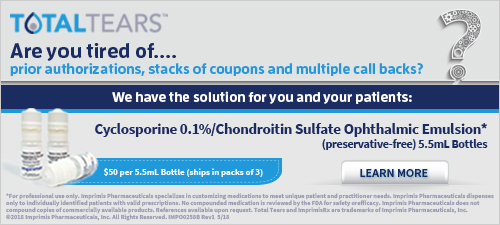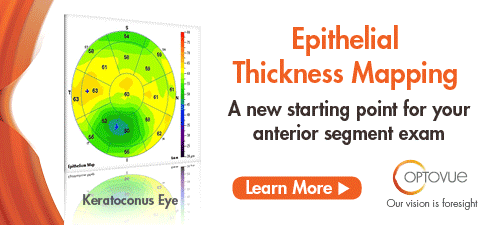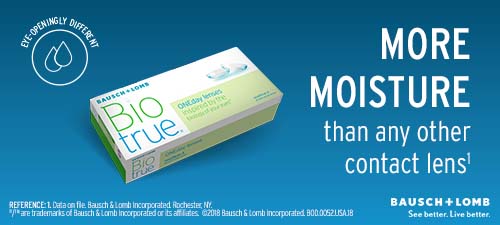
A
weekly e-journal by Art Epstein, OD, FAAO
Off the Cuff: The Great Dry North
While dry eye is among the hottest topics in the US today, we sometimes forget that dry eye disease is a growing global problem. Last week I had the pleasure of speaking at the inaugural Canadian Dry Eye Summit held in the Toronto area. The brainchild of Canadian dry eye guru Dr. Richard Maharaj, the Summit was sold out well in advance, and the sizeable room was packed with colleagues from all over Canada and the US.
|
|||||
 |
||
| Internal Carotid Artery Aneurysm Mimicking Normal-tension Glaucoma | ||||
Differentiating glaucomatous from nonglaucomatous optic disc cupping remains challenging, researchers wrote. They presented a case of a 48-year-old woman with an internal carotid aneurysm of approximately 3.5mm × 6.5mm that mimicked normal-tension glaucoma. The patient had a two-year history of low vision acuity in her left eye and frontal oppressive headache. Owing to the carotid aneurysm, she developed an asymmetric vertical cup-to-disc ratio above 0.2, and marked inferotemporal neuronal rim loss and pallor of the residual rim were noted in the left disc. She also developed a visual field defect with an arcuate scotoma in the left eye. The patient was referred to a neurosurgeon and underwent endovascular aneurysm occlusion. The case highlighted the diagnostic importance of recognizing that many neurological defects remain underdiagnosed. |
||||
SOURCE: Pincelli Netto M, Ferrari PV, Herrerias BT, et al. Internal carotid artery aneurysm mimicking normal-tension glaucoma. Arq Bras Oftalmol. 2018;81(2):148-52. |
||||
 |
||
| Glucose-sensitive Silicone Hydrogel Contact Lens Toward Tear Glucose Monitoring | ||||
Accurate and reliable monitoring of blood glucose is needed for the treatment of diabetes, which has many challenges, including lack of patient compliance. Measuring tear glucose is an alternative to traditional finger-stick tests used to track blood sugar levels, but glucose sensing using tears has yet to be achieved. Investigators reported a methodology for possible tear glucose monitoring using glucose-sensitive silicone hydrogel (SiHG) contact lenses, the primary type of lenses available in today's market.
Initially, investigators assessed the interpenetrating polymer network, with nearly pure silicone and water regions, existing in the SiHGs using polarity-sensitive probe Prodan. They then synthesized a glucose-sensitive fluorophore Quin-C18 with a hydrophobic side chain for localization of probe at the interfacial region. Using a glucose-sensing contact lens, they were able to measure varying concentrations of glucose in an in vitro system. The Quin-C18 strongly bound to the lenses with insignificant leaching, even after multiple rinses. The lenses displayed a similar response to glucose after three months of storage in water. Investigators determined that the study demonstrated that it might be possible to develop a contact lens for continuous glucose monitoring in the near term, using their concept of fluorophore binding at the silicone-water interface. |
||||
SOURCE: Badugu R, Reece EA, Lakowicz JR. Glucose-sensitive silicone hydrogel contact lens toward tear glucose monitoring. J Biomed Opt. 2018;23(5):1-9. |
||||
|
|||
| Severity of Primary Open-angle Glaucoma in Patients with Hypertension and Diabetes | ||||
Primary open-angle glaucoma (POAG) is a progressive optic neuropathy with numerous risk factors. Its severity with associated risk factors remains a widely debated topic. This hospital-based, cross-sectional descriptive study was conducted for a period of 18 months, from January 2016 to June 2017, to evaluate the severity of POAG in patients with hypertension (HTN) and diabetes, or both. Diagnosed cases of POAG were evaluated for severity with associated risk factors.
A total of 221 patients were enrolled in the study. The mean age of the patients was 54.4 (SD ± 15.9) years with a male to female ratio of 0.93:1. Of the 221 patients, 68 (31%) had a family history of POAG. Mean intraocular pressure was 15.8mm Hg ± 4.87mm Hg, and mean central corneal thickness was 535.4 μm ± 34.9 μm. A total of 81 (36%) patients had HTN, 21 (9.50%) had diabetes mellitus (DM), and 15 (6.80%) had both HTN and DM. Analysis using SPSS version 20 was performed. The severity of POAG was found to be significantly higher in patients with HTN, DM or both when evaluated on the basis of anatomical and functional loss. POAG patients with HTN, DM or both were found to have more severe POAG. Investigators wrote that patients with those risk factors could represent "high-risk patients" for POAG. They added that patients with HTN and DM or both may require evaluations on a more frequent basis to access the progression/severity of POAG. |
||||
SOURCE: Khatri A, Shrestha JK, Thapa M, et al. Severity of primary open-angle glaucoma in patients with hypertension and diabetes. Diabetes Metab Syndr Obes. 2018;11:209-215. |
||||
 |
||
| News & Notes | |
| Academy 2018 San Antonio Registration Open The American Academy of Optometry’s annual meeting, Academy 2018 San Antonio, will take place Nov. 7 to 10 at the Henry B. González Convention Center in San Antonio. Registration and housing are now open and early bird registration ends Sept. 7. This year’s plenary session, “Today’s Research, Tomorrow’s Practice: The Future of Health Care Delivery,” will discuss trends and concepts that will shape future practice. The Monroe J. Hirsch Research Symposium, “Vision Restoration for Retinal Degenerative Disease,” will bring together three leading researchers to highlight different approaches to save or restore sight in individuals with degenerative disease: gene replacement therapy, stem cell repair and optogenetics. The fourth joint symposium of the Academy and the American Academy of Ophthalmology, “Advances in Ocular Imaging,” will take on ocular imaging. Read more. |
|
| Tear Film Innovations Completes $8.5 Million Series B Funding Tear Film Innovations’ $8.5 million Series B Preferred Stock funding round was led by Visionary Ventures Fund and Bluestem Capital. The company’s iLux system, which received FDA 510k clearance in December 2017, enables eye care professionals to provide targeted therapy to blocked meibomian glands through an in-office treatment. Read more. |
|
| Nidek Launches LSFG-RetFlow Laser Speckle Flowgraphy Nidek introduced the LSFG-RetFlow Laser Speckle Flowgraphy for noninvasive, real-time imaging and measurement of ocular blood flow, to aid in the clinical evaluation of glaucoma and retinochoroidal vascular disease. The technology provides 16 indices of the retinochoroidal vascular dynamics based on the Mean Blur Rate, which measures relative blood flow velocity and correlates to the actual rate of blood flow. Read more. |
|
| Drug-eluting Contact Lens to Provide Timed Drug Delivery New, drug-eluting soft contact lens technology has been shown to deliver various drugs directly to the eye, and may one day improve postoperative recovery for people who undergo cataract and LASIK surgery or suffer corneal abrasions. The extended-wear contact, developed by biomedical researchers at Rowan University and Auburn University, controls the release of anti-inflammatory, anti-biotic and pain-reducing drugs delivered evenly over time. The technology can potentially reduce recovery time and postoperative complications thereby reducing health care cost. OcuMedic is expected to begin clinical studies necessary for FDA approval this year. Read more. |
|
| Envision Receives $300,000 for Workforce Innovation Center Envision received a $300,000 gift from The Sunderland Foundation for the construction of the William L. Hudson BVI Workforce Innovation Center. The center, to be housed in Envision’s headquarters, will be dedicated to training blind or visually impaired individuals, placing them into skilled positions and providing accessibility inclusion expertise to businesses around the United States. In addition, Envision kicked off a campaign to raise $1.5 million by Dec. 1 to receive a $750,000 challenge grant from the J.E. and L.E. Mabee Foundation. Read more. |
|
|
|
|
Optometric Physician™ (OP) newsletter is owned and published by Dr. Arthur Epstein. It is distributed by the Review Group, a Division of Jobson Medical Information LLC (JMI), 11 Campus Boulevard, Newtown Square, PA 19073. HOW TO ADVERTISE |


